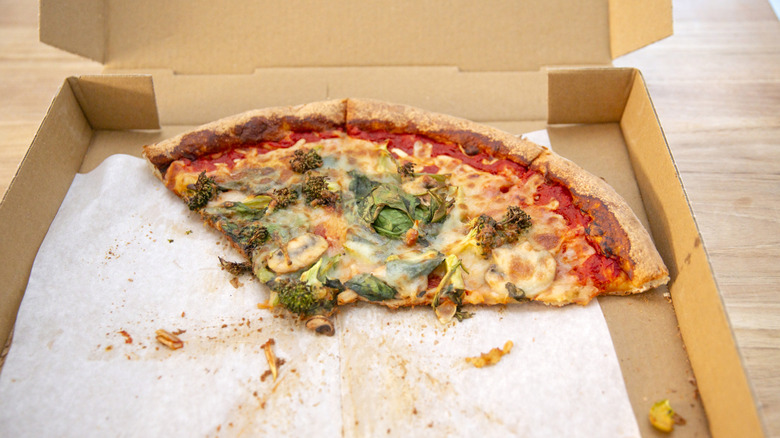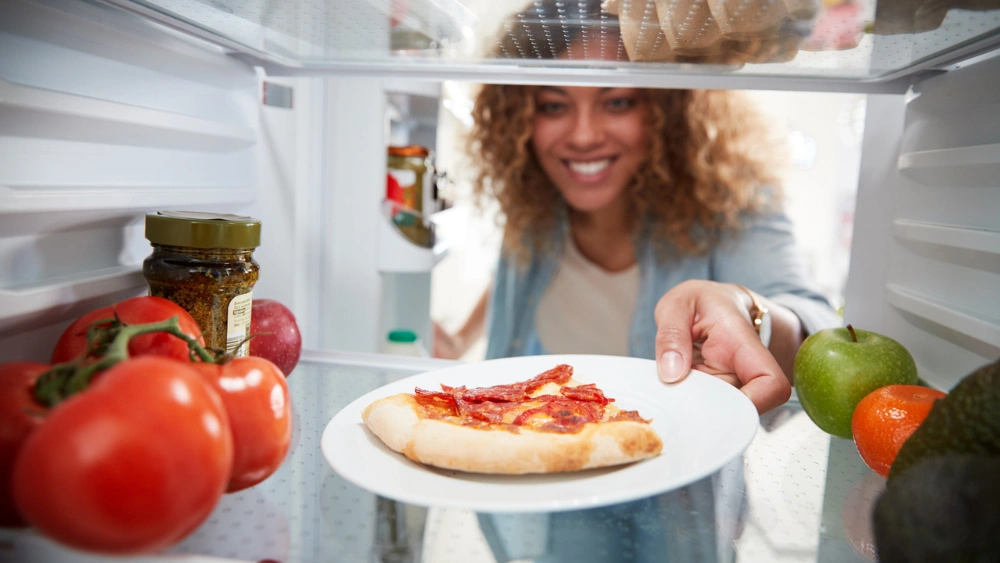Have you ever opened your fridge and wondered, “How long can pizza sit in here before it goes bad?” You’re not alone.
That leftover slice looks tempting, but eating spoiled pizza can quickly turn a tasty treat into an upset stomach. Knowing exactly how long your pizza stays fresh can save you from wasting food and protect your health. You’ll discover simple tips to keep your pizza safe and delicious, so you never have to second-guess that next bite.
Keep reading to find out the best way to store your pizza and how long it’s really okay to eat it after you’ve put it in the fridge.

Credit: www.facebook.com
Safe Storage Duration
Knowing the safe storage duration for pizza in the fridge helps prevent foodborne illness. Storing pizza properly keeps it tasty and safe to eat. It is important to follow guidelines for freshness and safety.
Typical Fridge Lifespan
Pizza usually stays fresh in the fridge for 3 to 4 days. After this time, bacteria can grow and cause spoilage. Cold temperatures slow down bacterial growth but do not stop it. Keep pizza in an airtight container or wrapped tightly in foil or plastic wrap. This prevents drying out and contamination from other foods.
Factors Affecting Freshness
- Temperature of the fridge: It should be below 40°F (4°C).
- Type of toppings: Meats and seafood spoil faster than vegetables.
- How quickly pizza was cooled before refrigeration.
- Storage method: Proper wrapping helps maintain moisture and taste.
- Exposure to air and bacteria from handling or open storage.

Credit: www.thetakeout.com
Signs Of Spoiled Pizza
You’ve just discovered a forgotten slice of pizza in the fridge. It happens to the best of us. But before you decide to indulge, how can you tell if that slice is past its prime? Knowing the signs of spoiled pizza is crucial to avoid any unwelcome surprises. Let’s dive into the clues that indicate your pizza might have seen better days.
Visual Clues
Start by examining your pizza closely. Has the cheese turned an odd color? If it’s beginning to look gray or has patches of mold, it’s time to toss it. The sauce can also give hints; a darker hue or any fuzz indicates spoilage. Even the crust can betray its freshness—look for any unusual dryness or discoloration.
Smell And Texture Changes
Your nose knows best. Take a whiff of the pizza. A sour or off smell is a clear indication that it’s no longer safe to eat. Texture changes are equally revealing. If the cheese feels slimy or the crust has become overly soggy, it’s a sign the pizza has overstayed its welcome in the fridge. So, what should you do when these changes are apparent?
Reflect on a time you ignored these signs and regretted it. It’s a lesson learned—never underestimate the power of your senses. Next time you face the pizza dilemma, be vigilant. What are your go-to checks to ensure your food is safe? Trust them and keep your stomach happy.
Best Practices For Storing Pizza
Storing pizza properly in the fridge can make a huge difference in taste and safety. You want to keep it fresh and avoid sogginess or unwanted odors. Knowing the right way to wrap and contain your pizza helps maintain its flavor and texture.
Proper Wrapping Techniques
Wrap your pizza slices tightly to keep air out. Use plastic wrap or aluminum foil and cover each slice individually. This prevents moisture loss and keeps the crust from drying out.
Another trick is to place a piece of parchment paper between slices before wrapping. It stops them from sticking together, so you can easily grab one without ruining the rest. Have you ever tried to pull apart cold pizza slices only to have the toppings come off? This simple step can save you from that frustration.
Ideal Container Choices
Choosing the right container is just as important as wrapping. Airtight containers work best because they lock in moisture and keep odors from other foods away. Glass or BPA-free plastic containers are great options.
If you don’t have airtight containers, use a resealable plastic bag and push out as much air as possible before sealing. Avoid containers that are too big; extra space lets air circulate and dries out your pizza faster.
Reheating Tips
Reheating pizza properly keeps its taste fresh and texture enjoyable. Choosing the right reheating method helps avoid soggy crusts or rubbery cheese. The goal is warm pizza with crispy edges and melty toppings.
Oven Methods
Preheat the oven to 375°F (190°C). Place pizza slices on a baking sheet or directly on the rack for a crispier crust. Heat for about 8 to 10 minutes. Check to avoid burning. This method keeps the crust crunchy and cheese melted evenly.
Microwave Tips
Microwaving is fast but can make the crust soggy. Place pizza on a microwave-safe plate. Use a cup of water next to the pizza to keep moisture balanced. Heat on medium power for 30 to 60 seconds. Check and add time in short bursts if needed. This keeps the toppings warm without drying out.
Skillet Approach
Heat a non-stick skillet over medium heat. Place pizza slice in the skillet without oil. Cover with a lid to trap heat. Cook for 5 to 7 minutes. The skillet crisps the crust while melting the cheese nicely. This method works well for a quick, tasty reheat.
Freezing Pizza For Longer Freshness
Freezing pizza helps keep it fresh much longer than just storing it in the fridge. It locks in flavor and texture, preventing spoilage. This method works well for both homemade and store-bought pizza. Proper freezing also stops bacteria growth, making your pizza safe to eat days later.
When To Freeze
Freeze pizza within two hours of cooking or buying. Wrap slices tightly in plastic wrap or aluminum foil. Place wrapped slices in a freezer-safe bag or container. Label with the date to track freshness. Freezing pizza soon after cooling keeps taste and texture better.
Thawing Safely
Thaw pizza in the fridge for several hours or overnight. Avoid thawing at room temperature to prevent bacteria growth. For quick thawing, use a microwave on a low setting. Reheat pizza in an oven or toaster oven for crispy crust. Proper thawing keeps pizza safe and tasty.
Health Risks Of Eating Old Pizza
Eating old pizza might seem harmless, especially when it looks and smells fine. But the truth is, leftover pizza can harbor bacteria that multiply over time, posing real health risks. Understanding these dangers helps you make smarter choices about when to toss and when to eat.
Food Poisoning Symptoms
Consuming pizza that’s been in the fridge too long can lead to food poisoning. Symptoms might show up within hours or even days after eating. Watch out for:
- Nausea and vomiting
- Stomach cramps and diarrhea
- Fever and chills
- Weakness and dehydration
These symptoms can be mild or severe depending on the bacteria involved. Have you ever felt sick after eating leftovers that seemed perfectly fine?
Preventive Measures
You can avoid these risks by handling leftover pizza the right way. Always refrigerate pizza within two hours of cooking. Keep it in an airtight container or wrap it tightly in plastic wrap or foil.
Eat refrigerated pizza within 3 to 4 days. If you notice any strange smell, slimy texture, or discoloration, it’s safer to throw it away. Reheating pizza thoroughly until it’s steaming hot can also kill most harmful bacteria.
Do you check the storage time before reheating your leftovers? Developing this habit can protect your health and save you from unexpected trips to the doctor.

Credit: www.instagram.com
Frequently Asked Questions
How Long Can Pizza Stay Fresh In The Fridge?
Pizza can stay fresh in the fridge for 3 to 4 days. Store it in an airtight container or wrap it tightly with foil or plastic wrap to maintain quality and prevent drying out.
Is It Safe To Eat Pizza After 5 Days Refrigerated?
Eating pizza after 5 days in the fridge is risky. Bacteria may grow, causing foodborne illness. It’s best to discard pizza older than 4 days for safety.
Can I Freeze Leftover Pizza To Extend Shelf Life?
Yes, freezing leftover pizza extends its shelf life up to 1-2 months. Wrap slices tightly in foil or plastic wrap before freezing to preserve flavor and texture.
How To Tell If Refrigerated Pizza Has Gone Bad?
Check for sour smell, mold, or slimy texture. If pizza looks or smells off, discard it immediately to avoid food poisoning and maintain health safety.
Conclusion
Pizza stays fresh in the fridge for about three to four days. Eat it within this time to enjoy the best taste and avoid sickness. Always store pizza in an airtight container or wrap it well. Avoid leaving pizza out at room temperature for more than two hours.
Reheat it properly to keep it safe and tasty. Remember, safe storage keeps your food good and your body healthy. Enjoy your leftover pizza, but do it smartly!

